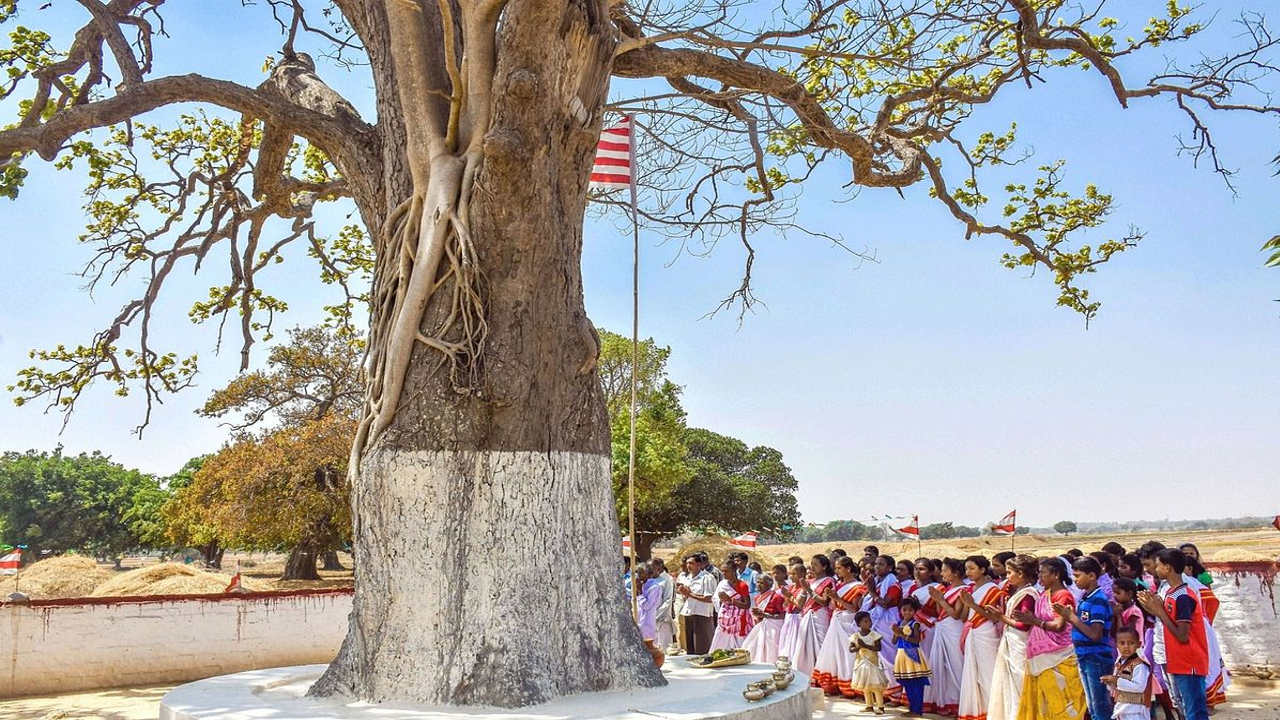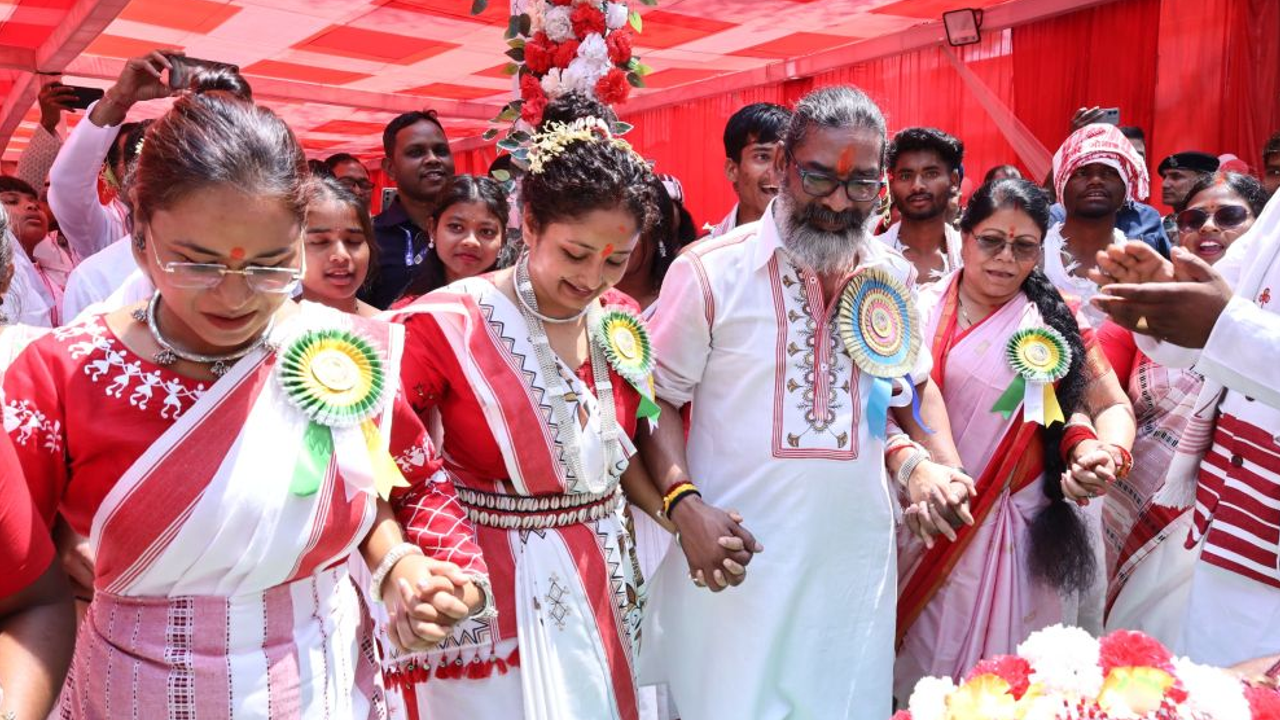Sarhul: Jharkhand’s Grand Celebration of Nature, Tradition, and Community


Web desk
Published on Apr 01, 2025, 06:45 PM | 4 min read
Ranchi: With the rhythmic beats of dhol and mandar echoing through the streets, Jharkhand came alive today in celebration of its most significant tribal festival, Sarhul. This festival, marking the arrival of spring, embodies the deep-rooted bond between tribal communities and nature, a relationship steeped in reverence, gratitude, and cultural heritage.
Sarhul, meaning ‘worship of Sal trees,’ is one of the most awaited festivals in Jharkhand’s tribal culture.Celebrated on the third day of Chaitra, the first month of the Hindu calendar, the festival heralds the beginning of a new season. More than just a festival, Sarhul is a spiritual occasion that forges connections between people, their ancestors, the environment, and traditions passed down for generations.
At the heart of Sarhul lies the worship of the Sal tree, a sacred symbol believed to represent life, sustenance, and protection. Tribes believe that offering prayers to the tree ensures prosperity, good health, and a bountiful harvest. This festival also reinforces the fundamental tribal belief in the inseparable union between humans and nature.
The celebrations begin with a series of rituals led by the ‘pahans’ (tribal priests). In the morning, people gather at the Sarna Sthal, the sacred groves where prayers are offered to nature gods. A unique and ancient ritual involves placing two earthen pots filled with water under a Sal tree overnight. The next morning, the priest examines the water level in these pots to predict the year’s monsoon rainfall, an important indicator of agricultural prospects for the coming season.
Following the rituals, grand processions take over the streets, with men, women, and children adorned in traditional tribal attire. They dance joyfully to the beats of tribal drums and sing folk songs that narrate tales of their ancestors and the land. The pulsating rhythms of dhol and mandar, complemented by the soothing melodies of the flute, create an electrifying atmosphere. Participants smear turmeric and vermillion on each other, adding vibrant hues to the festivities.
Traditional dance forms such as ‘Paika’ and ‘Chhau’ bring another layer of cultural richness to Sarhul. These dances, depicting stories of valor and divine blessings, are more than just performances; they serve as a powerful medium for storytelling and cultural preservation, ensuring that ancestral traditions endure through generations.
Traditional Feast and Community Bonding
Food plays a central role in Sarhul, with special dishes prepared using locally available ingredients. A festival highlight is ‘handia,’ a traditional rice beer made from fermented rice, shared among family and friends as a symbol of unity and joy.
The festival feast includes delicacies such as ‘mahua laddoo’ (a sweet made from mahua flowers), ‘dubki’ (a lentil dish), and ‘bamboo shoot curry.’ Meat dishes, particularly chicken and mutton preparations, are also an integral part of the celebrations. These meals, considered sacred, are first offered to deities before being enjoyed by the community.
Beyond the feast, Sarhul carries a strong environmental message. A notable tradition during the festival is the planting of Sal tree saplings as a mark of gratitude to nature. This act reaffirms the tribal ethos of environmental conservation, a principle deeply ingrained in their way of life.
Who Celebrates Sarhul?
Sarhul is primarily observed by the Oraon, Munda, and Ho tribes of Jharkhand. However, its appeal has transcended tribal communities over the years. Many non-tribal residents also participate in the festivities, recognizing Sarhul as a symbol of cultural harmony and environmental consciousness.
The festival is particularly grand in districts such as Ranchi, Gumla, Khunti, Simdega, and Lohardaga, where large tribal populations reside. Educational institutions, social organizations, and local governing bodies actively engage in the celebrations, promoting awareness of tribal heritage and the importance of preserving indigenous traditions. Jharkhand Chief Minister Hemant Soren, his wife, and legislator Kalpana Soren performed rituals on the occasion of the annual festival Sarhul at Tribal College Hostel, Karamtoli, Ranchi
Jharkhand Chief Minister Hemant Soren, his wife, and legislator Kalpana Soren performed rituals on the occasion of the annual festival Sarhul at Tribal College Hostel, Karamtoli, Ranchi
Acknowledging the cultural and social significance of Sarhul, the Jharkhand government has declared a two-day state holiday to enable full participation in the festivities. This decision, announced by Chief Minister Hemant Soren, has been widely welcomed by the tribal community.
“Festivals connect us to our traditions, civilization, culture, and faith. They infuse life with enthusiasm, excitement, and joy. Our ancestors have preserved and strengthened the traditions of this nature festival, keeping them intact. We must carry it forward,” said Soren while addressing a gathering at the Tribal College Hostel in Ranchi’s Karam Toli.
In keeping with the spirit of the festival, the Chief Minister planted a Sakhua tree on the hostel premises, reinforcing the importance of staying connected to nature. Immersing himself in the celebrations, he also participated in the traditional dance, moving to the beats of the dhol and mandar alongside the tribal community.










0 comments